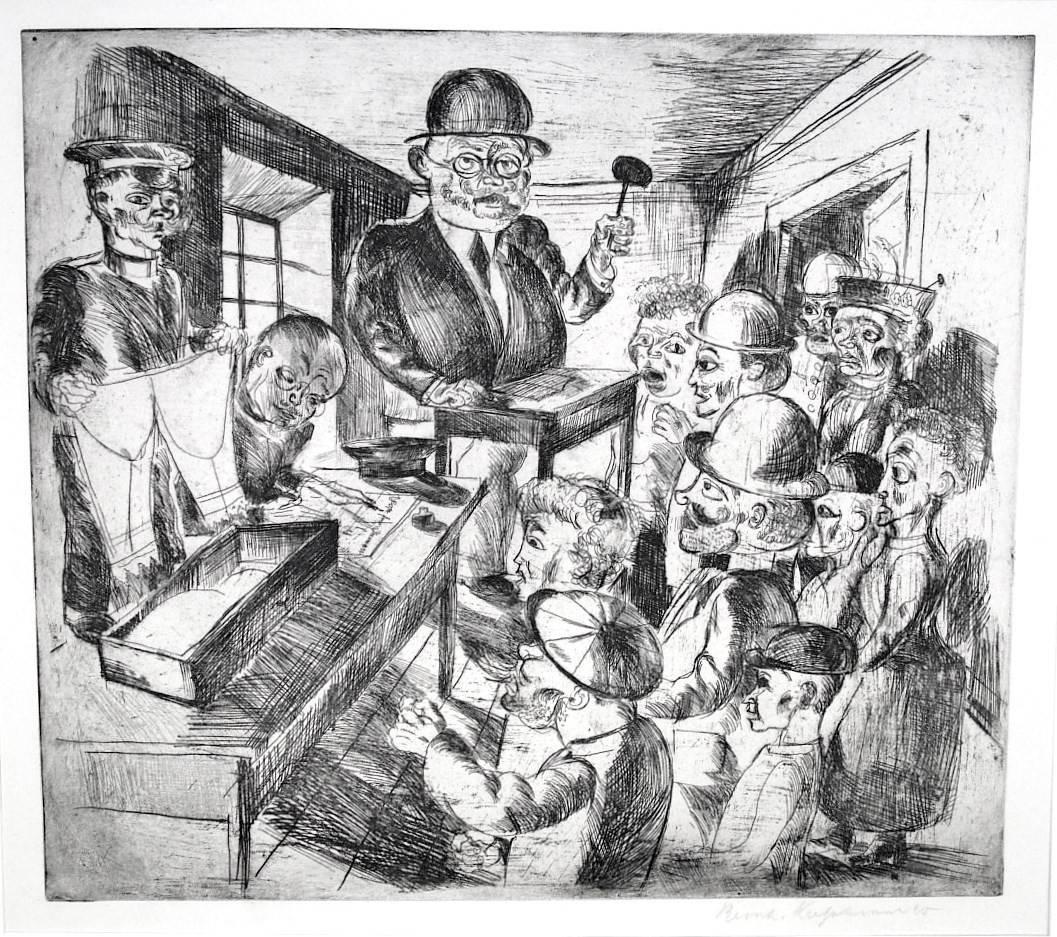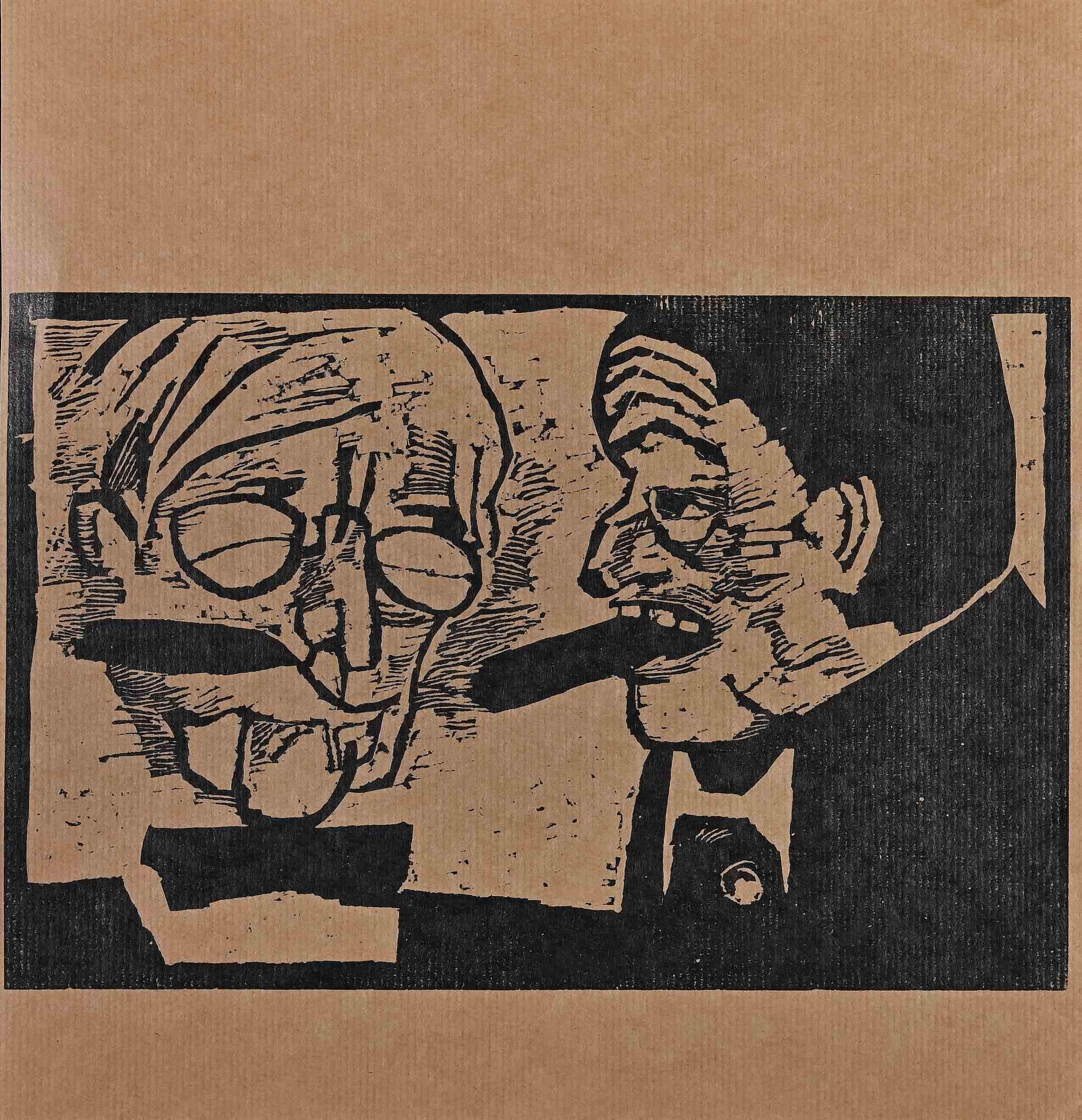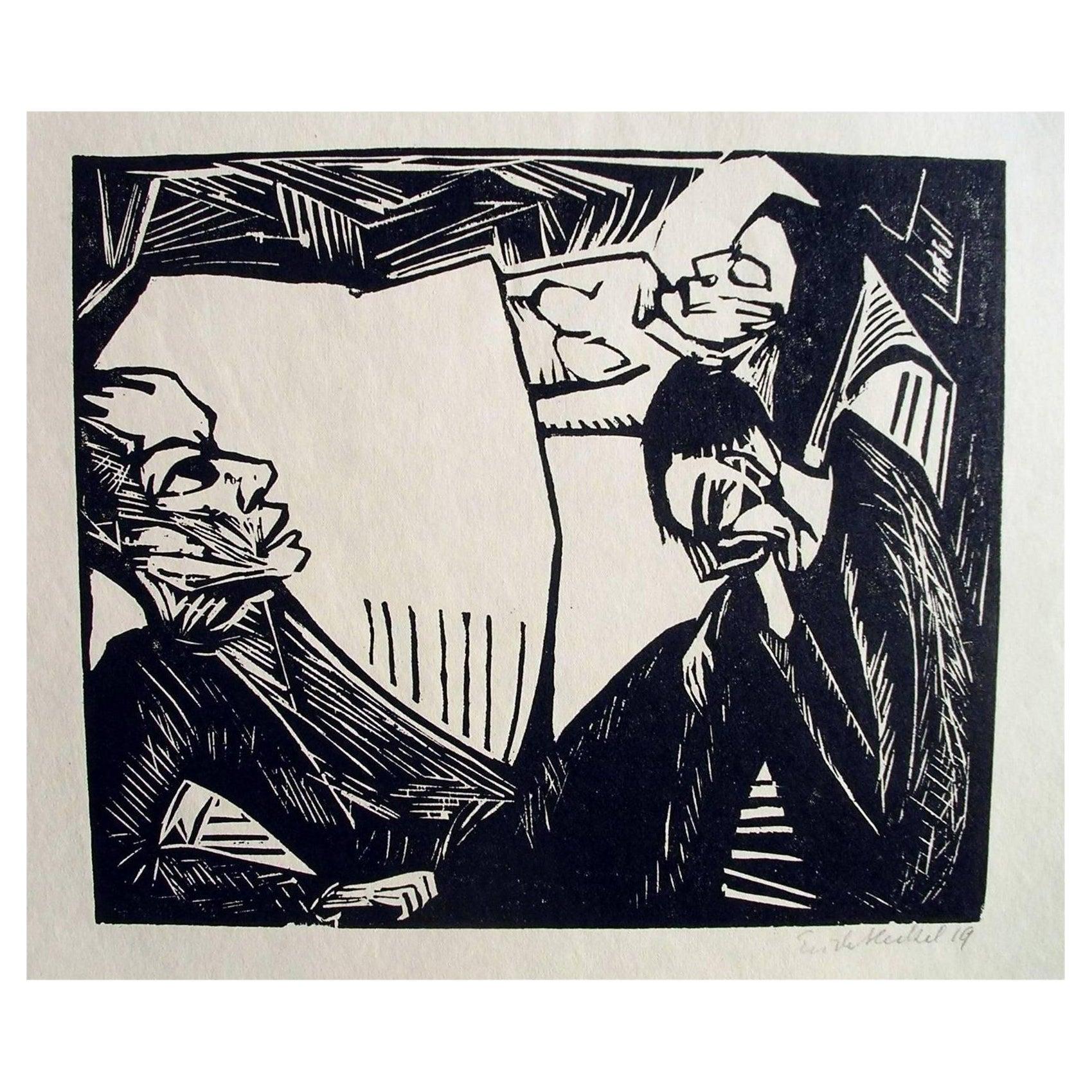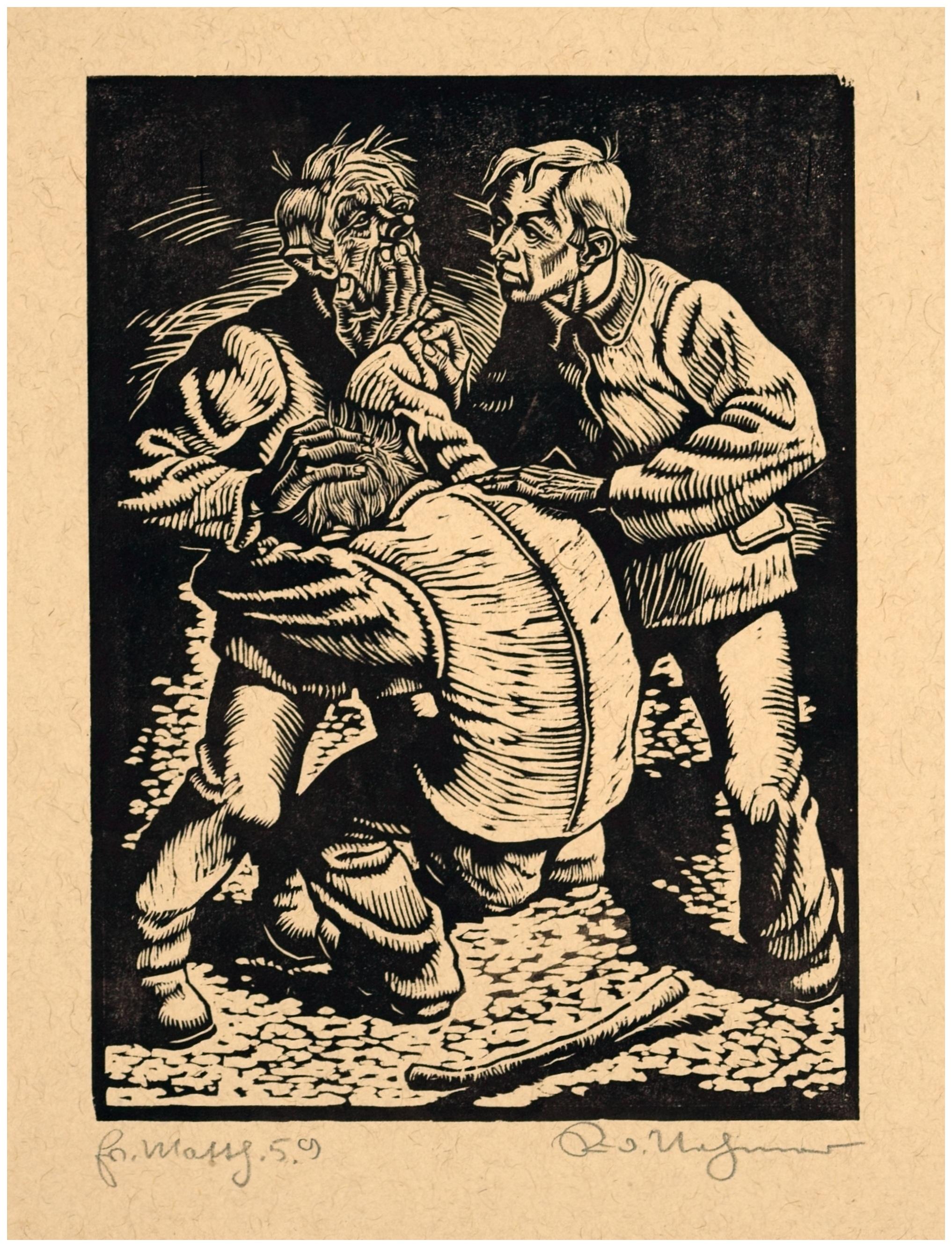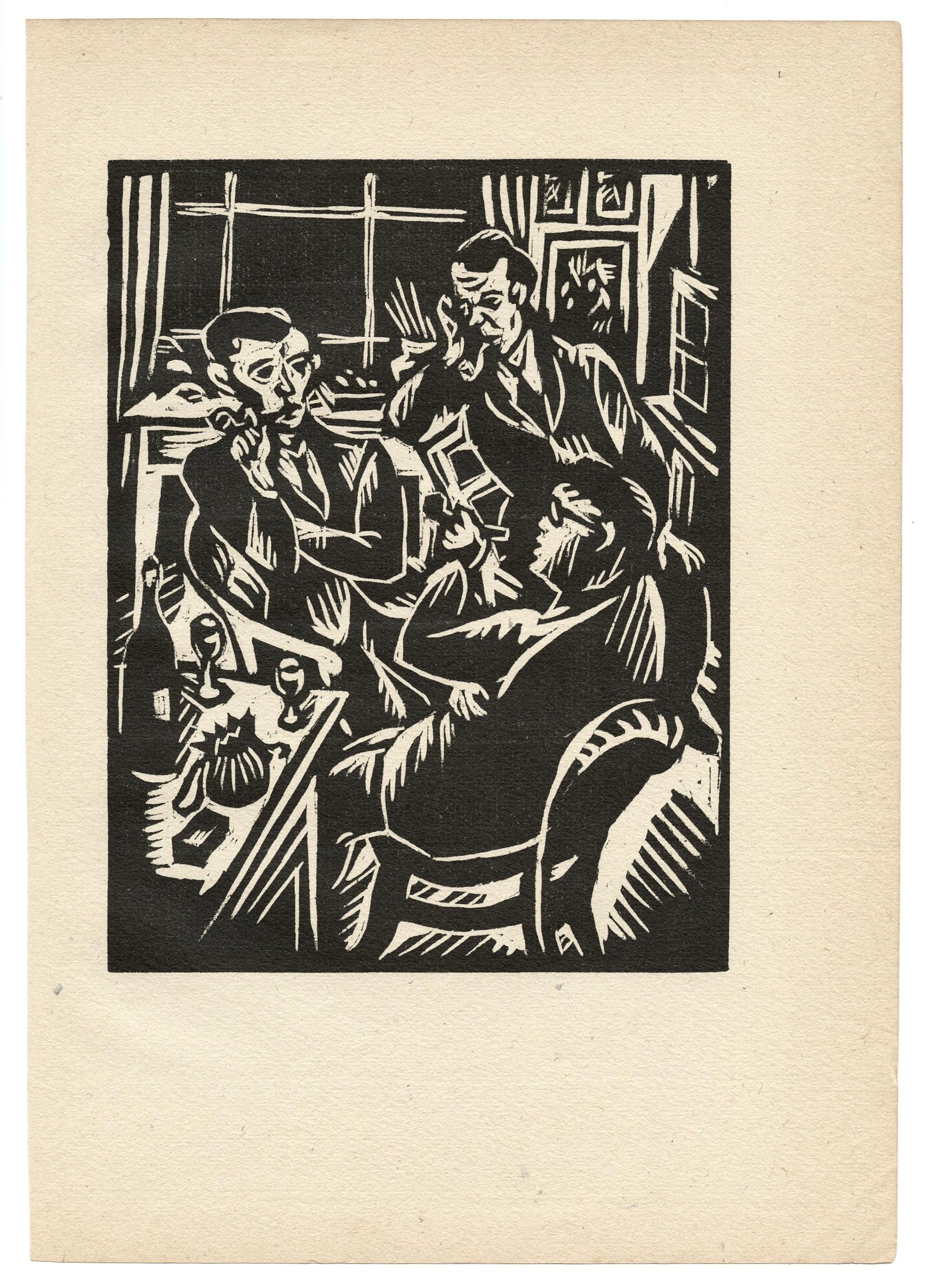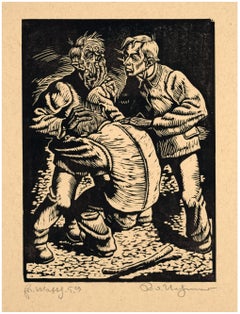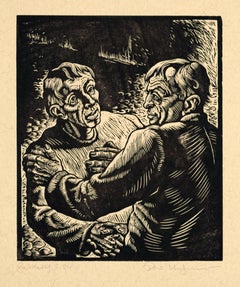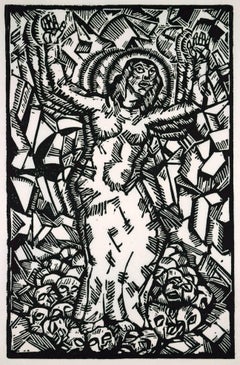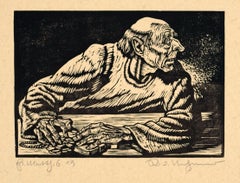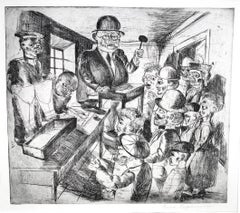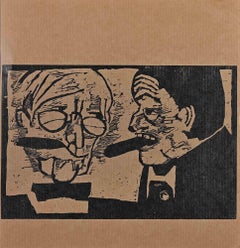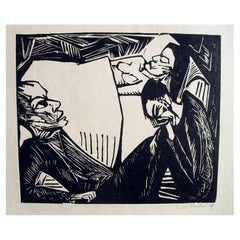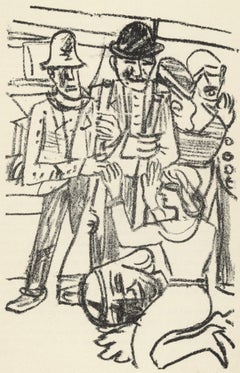Items Similar to Mockery / - Desk Perpetrators -
Want more images or videos?
Request additional images or videos from the seller
1 of 7
Josef ScharlMockery / - Desk Perpetrators -1964
1964
$359.21
$449.0120% Off
£273.36
£341.7020% Off
€304
€38020% Off
CA$502.83
CA$628.5420% Off
A$554.08
A$692.6020% Off
CHF 287.39
CHF 359.2420% Off
MX$6,590.05
MX$8,237.5720% Off
NOK 3,635.44
NOK 4,544.3020% Off
SEK 3,405.63
SEK 4,257.0420% Off
DKK 2,315.83
DKK 2,894.7920% Off
About the Item
Josef Scharl (1896 Munich - 1954 New York), Mockery, 1935 (1964), Bronner 30 A. Woodcut on Japanese paper, 51.8 x 25.7 cm (image), 65 cm x 37 cm (sheet size), signed lower right in the printing block with the initials “JS”, identified lower left in lead as copy no. 30 / 30 and signed in lead by Alois Scharl on the reverse. This is a reprint from the original printing block made by Galerie Nierendorf in 1964.
- Slight creases in the left corners and mounting residue on the reverse, otherwise in excellent, fresh condition
- Desk Perpetrators -
At the end of a conference table that extends into the picture, St. Sebastian stands, pierced by arrows. In contrast to the people in suits, he wears only a loincloth, adding to the contrast with the "other" people. As desk-bound perpetrators, they have brought about the martyrdom with their "long-range weapons" and elevate themselves above the saint by completely ignoring him and the suffering they have caused and instead continuing with their usual actions. And yet the saint is the real protagonist of the image. He is approached by the white surface of the table, which appears as bright as Sebastian's body, while those seated at the table are dressed in dark clothes. His body and face also radiate a beauty that makes the ugliness of the perpetrators appear all the more striking.
Josef Scharl's large-format woodcut, created in 1935, reflects the approaching inhuman era of murder.
About the artist
In addition to training as a decorative painter, which he began in 1910, Josef Scharl attended evening classes in nude painting. After his military service from 1915 to 1918, he studied at the Munich Art Academy from 1919 to 1921 under Angelo Jank and Heinrich von Zügel. However, he turned his back on the academy and joined the Munich New Secession in 1923 and the artists' association 'Die Juryfreien' in 1929. During these years Scharl became a recognized artist, which was reflected in the awarding of the Dürer Prize of the City of Nuremberg (1929), the Rome Prize of the Berlin Academy of Art (1930), the Prize of the Munich Academy (1931), and the Förderpreis of the City of Essen (1932). The Rome Prize enabled him to spend extended periods in Rome and Paris from 1930 to 1932. As a member of the Deutscher Künstlerbund, he participated in its annual exhibitions from 1930 to 1936.
After the National Socialists seized power, Scharl's works were still shown in solo exhibitions at the renowned Neumann-Nierendorf Gallery in Berlin until 1935, but the artist was increasingly subjected to reprisals and emigrated to the USA via Switzerland without his family in 1938. He was motivated to do so by an invitation from the Museum of Modern Art to exhibit together with Max Beckmann, Georg Scholz, Erich Heckel and Karl Hofer.
In the USA, Scharl was supported by Albert Einstein, with whom he was on friendly terms and who wrote a memorial speech after the artist's death in 1954. In 1945, Karl Nierendorf published Scharl's first American monograph and presented his drawings in his New York gallery. Through Wolfgang Sauerländer, the artist illustrated the fairy tales of the Brothers Grimm for the publisher ‘Pantheon Books’. The book, published in 1944, enjoyed great popularity and led to further follow-up commissions. Josef Scharls became a US citizen in 1952 and died two years later.
GERMAN VERSION
Josef Scharl (1896 München - 1954 New York), Verspottung, 1935 (1964), Bronner 30 A. Holzschnitt auf Japanpapier, 51,8 x 25,7 cm (Darstellung), 65 cm x 37 cm (Blattgröße), unten rechts im Druckstock mit den Initialen „JS“ signiert, unten links in Blei als Exemplar Nr. 30 / 30 ausgewiesen und rückseitig in Blei von Alois Scharl signiert. Es handelt sich um den 1964 von der Galerie Nierendorf angefertigten Nachdruck vom originalen Druckstock.
- an den linken Eckbereichen leichte Knickspuren und dort rückseitig Montagereste, ansonsten in ausgezeichnetem farbfrischem Zustand
- Schreibtischtäter -
Am Ende eines ins Bild hineinfluchtenden Konferenztisches steht der von Pfeilen durchbohrte Heilige Sebastian. Im Gegensatz zu den Anzugsträgern ist er bloß mit einem Lendenschurz bekleidet, was den Kontrast zur gänzlich ‚anderen Sorte‘ Mensch noch erhöht. Als Schreibtischtäter haben sie das Martyrium mit ihren ‚Fernwaffen‘ herbeigeführt und erheben sich über den Heiligen, indem sie ihn und damit das durch sie verursachte Leid gänzlich ignorieren und stattdessen in ihrem üblichen Agieren fortfahren. Und doch ist der Heilige der eigentliche Protagonist des Bildes. Auf ihn läuft die weiße Fläche des Tisches zu, die ebenso hell erscheint wie Sebastians Körper, während die am Tisch Sitzenden dunkel gekleidet sind. Auch strahlen sein Körper und sein Gesicht eine Schönheit aus, die die Hässlichkeit der Täter umso frappierender erscheinen lässt.
Mit dem 1935 geschaffenen großformatigen Holzschnitt reflektiert Josef Scharl die heraufziehende menschenverachtende Zeit des Mordens.
zum Künstler
Neben einer 1910 begonnenen Ausbildung zum Dekorationsmaler besuchte Josef Scharl Abendkurse für Aktmalerei. Nach dem von 1915 bis 1918 absolvierten Kriegsdienst studierte er von 1919 bis 1921 an der Münchener Kunstakademie bei Angelo Jank und Heinrich von Zügel. Er kehrte der Akademie allerdings den Rücken und schloss sich 1923 der Münchener Neuen Secession und 1929 der Künstlervereinigung ‚Die Juryfreien‘ an. In diesen Jahren wurde Scharl zuem anerkannten Künstler, was sich in der Verleihung des Dürerpreis der Stadt Nürnberg (1929), dem Rompreis der Berliner Kunstakademie (1930), dem Preis der Münchner Akademie (1931) und dem Förderpreis der Stadt Essen (1932) niederschlug. Der Rompreis ermöglichte ihm von 1930 bis 1932 längere Aufenthalte in Rom und Paris. Als Mitglied des Deutschen Künstlerbundes nahm er von 1930 bis 1936 an den Jahresausstellungen teil.
Nach der Machtergreifung der Nationalsozialisten fanden zwar bis 1935 noch Einzelausstellungen von Scharls Werken in der renommierten Berliner Galerie Neumann-Nierendorf statt, doch sah sich der Künstler zusehends Repressalien ausgesetzt, so dass er 1938 ohne seine Familien über die Schweiz in die USA emigrierte. Dazu motivierte ihn eine Einladung des Museum of Modern Art gemeinsam mit Max Beckmann, Georg Scholz, Erich Heckel und Karl Hofer auszustellen.
In den USA wurde Scharl von Albert Einstein unterstützt, mit dem er freundschaftlich verbunden war und der nach dem Tod des Künstlers 1954 eine Gedenkrede verfasste. 1945 publizierte Karl Nierendorf die erste amerikanische Monographie Scharls und präsentierte dessen Zeichnungen in seiner New Yorker Galerie. Durch Vermittlung Wolfgang Sauerländers illustrierte der Künstler für den Verlag ‚Pantheon Books‘ die Märchen der Brüder Grimm. Das 1944 erschienene Buch erfreute sich großer Beliebtheit und führte zu weiteren Folgeaufträgen. 1952 wurde Josef Scharls US-Amerikanischer Staatsbürger und verstarb zwei Jahre später.
- Creator:Josef Scharl (1896 - 1954, American, German)
- Creation Year:1964
- Dimensions:Height: 24.81 in (63 cm)Width: 18.12 in (46 cm)Depth: 0.4 in (1 cm)
- Medium:
- Movement & Style:
- Period:
- Condition:
- Gallery Location:Berlin, DE
- Reference Number:1stDibs: LU2438216127012
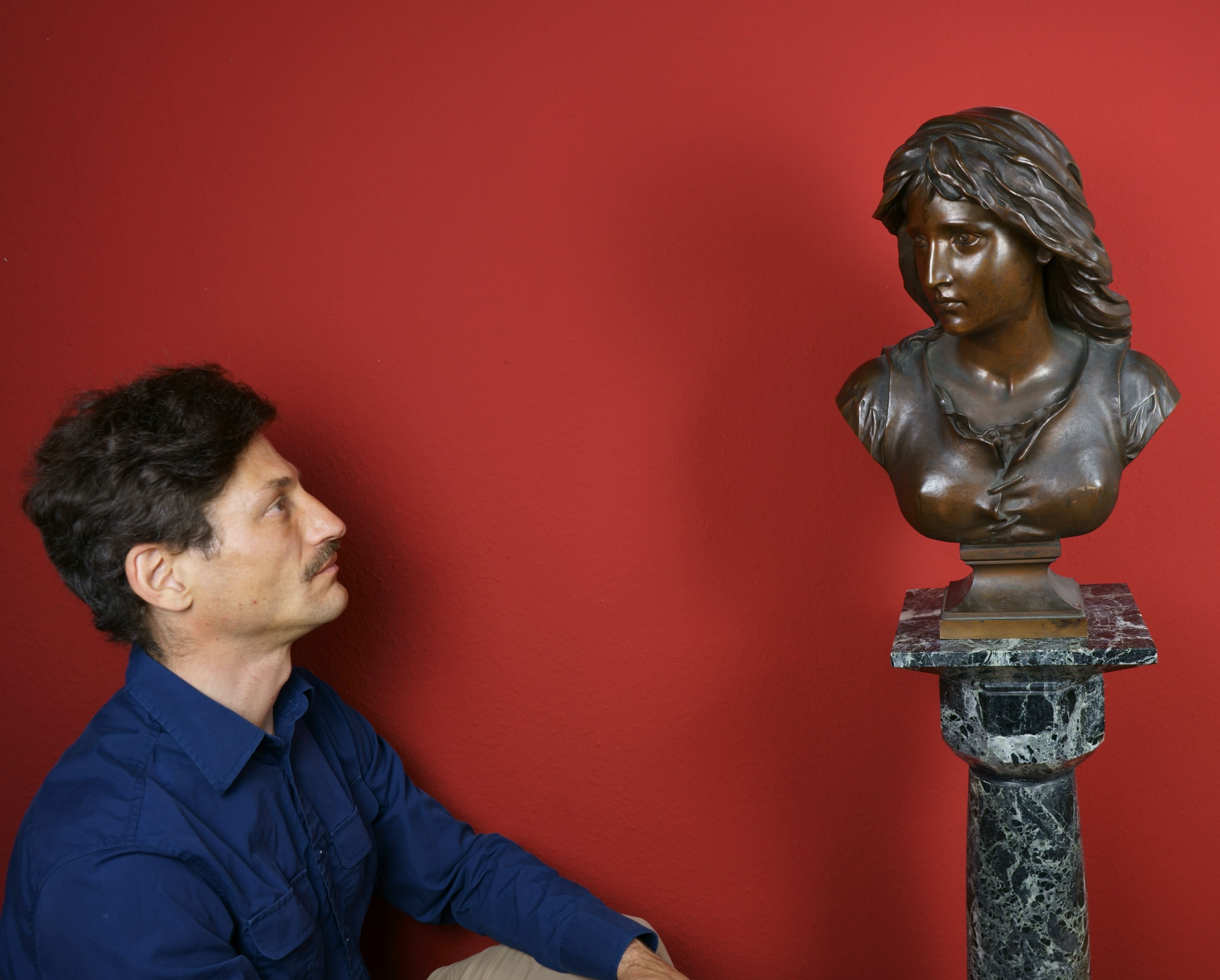
About the Seller
5.0
Vetted Professional Seller
Every seller passes strict standards for authenticity and reliability
Established in 2014
1stDibs seller since 2023
22 sales on 1stDibs
- ShippingRetrieving quote...Shipping from: Berlin, Germany
- Return Policy
More From This Seller
View AllBlessed are the peacemakers / - Dehumanization -
Located in Berlin, DE
Rudolf Nehmer (1912 Bobersberg - 1983 Dresden), Blessed are the peacemakers, 1948. Woodcut on yellowish wove paper, 18 cm x 15.5 cm (image), 45 cm x 30 cm (sheet size), signed “Rud.[...
Category
1940s Realist Figurative Prints
Materials
Woodcut
$170 Sale Price
20% Off
The Reconciliation / - Togetherness -
Located in Berlin, DE
Rudolf Nehmer (1912 Bobersberg - 1983 Dresden), The Reconciliation, 1948. Woodcut on yellowish wove paper, 20 cm x 15 cm (image), 45 cm x 30 cm (sheet size), signed “Rud.[olf] Nehmer...
Category
1940s Realist Figurative Prints
Materials
Woodcut
$170 Sale Price
20% Off
The Mother / - Violated Motherhood -
By Georg Tappert
Located in Berlin, DE
Georg Tappert (1880 Berlin - 1957 Berlin), The Mother, 1918 (1964). Estate print from 1964. Linocut on Japan, 31.5 cm x 20 cm (image), 44.5 cm x 28 cm (sheet size), marked lower left...
Category
1910s Expressionist Figurative Prints
Materials
Paper
$264 Sale Price
20% Off
Greed / - The Poverty of Wealth -
Located in Berlin, DE
Rudolf Nehmer (1912 Bobersberg - 1983 Dresden), The birds under the sky, 1948. Woodcut on yellowish wove paper, 11 cm x 18 cm (depiction), 43 cm x 30 cm (sheet size), signed “Rud.[ol...
Category
1940s Realist Figurative Prints
Materials
Woodcut
$170 Sale Price
20% Off
The Zero Hour / - After the End of the World -
Located in Berlin, DE
Rudolf Nehmer (1912 Bobersberg - 1983 Dresden), The Zero Hour, 1948. Woodcut on yellowish wove paper, 20 cm x 14.8 cm (image), 43 cm x 30 cm (sheet size), signed “Rud.[olf] Nehmer” i...
Category
1940s Realist Figurative Prints
Materials
Woodcut
$264 Sale Price
20% Off
The fruitless tree / - The End of the Grotesque Era -
Located in Berlin, DE
Rudolf Nehmer (1912 Bobersberg - 1983 Dresden), The fruitless tree, 1948. Woodcut on yellowish wove paper, 15 cm x 14.6 cm (image), 45 cm x 30 cm (sheet size), signed “Rud.[olf] Nehm...
Category
1940s Realist Figurative Prints
Materials
Woodcut
$170 Sale Price
20% Off
You May Also Like
Auction
By Bernhard Kretzschmar
Located in New York, NY
Bernard Kretzschmar (1889-1972), Auction, etching, drypoint, and burnished aquatint, 1921, signed and dated (’20) in pencil lower right [also initialed in the plate lower left] Refe...
Category
1920s Expressionist Figurative Prints
Materials
Drypoint, Etching, Aquatint
Men With Cigar - Woodcut - Early 20th Century
Located in Roma, IT
Men With Cigar is a woodcut print realized by an Anonymous artist in the early 20th Century.
Good condition.
The artwork is depicted through quick and expressive strokes in a well-...
Category
Early 20th Century Expressionist Figurative Prints
Materials
Woodcut
$226 Sale Price
20% Off
Erich Heckel German Expressionist Woodblock Print, 1919 "Dostoevski's Idiot"
By Erich Heckel
Located in Phoenix, AZ
Erich Heckel (1883-1970) Original Woodblock print, 1919.
“Dostoevski's Idiot (Final Scene)”
Unframed and in excellent condition.
Image size: 9 3/4" H x 11 1/2" W.
In a 16" H x 20" ...
Category
Early 20th Century Figurative Prints
Materials
Paper
Beckmann, Composition (Hofmaier 323-329), Der Mensch ist kein Haustier (after)
By Max Beckmann
Located in Southampton, NY
Lithograph on Van Gelder Zonen Bütten paper. Inscription: Unsigned and unnumbered, as issued. Good condition. Notes: From the volume, Der Mensch ist kein Haustier, 1937. Published by...
Category
1930s Modern Figurative Prints
Materials
Lithograph
$1,036 Sale Price
58% Off
Free Shipping
"In Memorium Rene Beeh" original woodcut
Located in Henderson, NV
Medium: original woodcut. This impression on laid paper was printed in Germany in 1922 for the rare Ganymed portfolio "Das vierte Jahrbuch der Marees Gesellschaft" and published in M...
Category
1920s Expressionist Prints and Multiples
Materials
Woodcut
Interrogation - Original Lithograph and Offset by George Grosz - 1925
By George Grosz
Located in Roma, IT
Interrogation is an original offset and lithograph realized by George Grosz.
The artwork is from the book "Kobes" by Heinrich Man, that Grosz illustrated with 10 drawings reproduce...
Category
1920s Expressionist Figurative Prints
Materials
Lithograph, Offset
$230 Sale Price
35% Off
